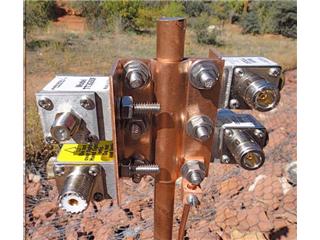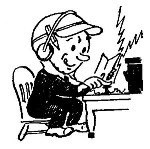Many hams have a VHF/UHF radio and antenna for local communication, especially if they are involved in EmComm. Ideally you have an exterior antenna up high for best performance with your radio. The downside to that is that vertically-oriented VHF/UHF monopole antennas are a juicy target for lightning strikes. Basically, they look like a lightning rod.

Lightning wants to go to ground and if the best path is through your antenna and feed line, your radio is likely to be destroyed. And if you’re right near the radio when it happens, you might be injured, or a fire might be started by the lightning strike. Bottom line, bad things can happen with an outdoor antenna during a thunderstorm.

Lightning protection is important to have. There are numerous sources of arresters available, mostly for coaxial cable (feed line). Some simple and cheap, others complex and costly. How much is your radio and even your house worth to you?
Here are some commonly available coaxial cable lightning arresters:



Even better than these stand-alone arresters with separate ground wires is to group them on a plate that is well-grounded.

Special ground rods with arrester mounting plates are available for this:

Common lightning arresters on your antenna feed line help only with minor stray lightning bolts. A direct strike on your antenna cannot be stopped by a simple arrester; there is too much energy involved to dissipate. The radio will be destroyed in such a case, along with possible damage and injury.
So what can you do to protect yourself and your radio from lightning? In addition to using arresters the best way is to unplug the coaxial cable from the radio and stick the end out a window or pointing towards a good ground away from any electronics. This is generally good practice during a thunderstorm or when you leave home for an extended period of time and stormy weather might arise.

“But, but, but… “, we hear you say: “If I unplug my antenna, how can I monitor the repeater during a weather net and report in or at least listen for current conditions?” Well, here is where it is good to have an indoor or attic antenna as a backup. The roof and walls will shield the antenna from lightning strikes. Of course, performance won’t be as good as with an outdoor antenna up high, but it may be good enough.
Attic installation is best because it gets you as high as practical. That is unless you have a metal roof or radiant barrier. These will block most of the electromagnetic waves coming to or from your antenna. Still, depending on the roof shape and how much metal surrounds the antenna, some signal may get in or out. You’ll never know without testing and experimentation.

If you have a full-metal jacket around your attic you will need to put up an indoor antenna. You might hang a roll-up J-pole on the wall or even use a mobile antenna resting on a cookie sheet. The higher you can get it inside your house the better. The closer to an exterior wall the better, particularly in the direction of the repeater.
Another option is to use your mobile radio in your vehicle where you are unlikely to be struck by lightning. The downside to this is you’re sitting in your car for who knows how long.
HF vertical antennas are similarly prone to lightning strikes. Horizontal wire antennas may also present a lightning hazard but to a lesser degree, depending on height and exposure. These should similarly be disconnected during a storm.
Play it safe and disconnect all outdoor antennas during a thunderstorm and use your VHF/UHF indoor backup as needed.
Lightning protection is a big and sometimes controversial topic. Many different opinions, most rather strong. We can only suggest that the reader do their own research and arrive at their own conclusion.
Lightning protection is a significant topic in the US ham license exam question pools, exemplified below:
All ground wiring used for lightning protection should have minimal bending. Sharp angles of wire form natural arc nodes for a spark or flash from lightning or static discharge.

Similarly, keep grounding wires short and make a direct path to minimize resistance and avoid proximity to other objects or wires.

Lightning protection ground wires should be connected to all other ground wires and connections for maximum protection.

Always connect/bond ground wires mechanically (crimp/screw), never by soldering. In case of a high current lightning strike the solder will melt and the connection may separate. This is true of all high-current connections, not just for lightning, BTW.


Have you seen this?: https://wr9r.com/product/antenna-disconnect/
LikeLike
Useless gimick; lightening will shoot straight across that gap.
LikeLike
Great Idea, but no cigar.
issue here is
1. Plastic frame. If lightning does come down the coax, it will be hot enough to melt the plastic.
2. no ground.
3. If lightning can travel miles through the sky, it can easily arc to the other connector.
LikeLike
I am wondering where the ground for the disconnect device is located.
LikeLike
I have all my feedlines underground going to an antenna shed. When there is storm coming or being gone long, I go out and disconect lines to house. Ground ants before remote remote switches may help them but probaly not. kc0csr
LikeLike